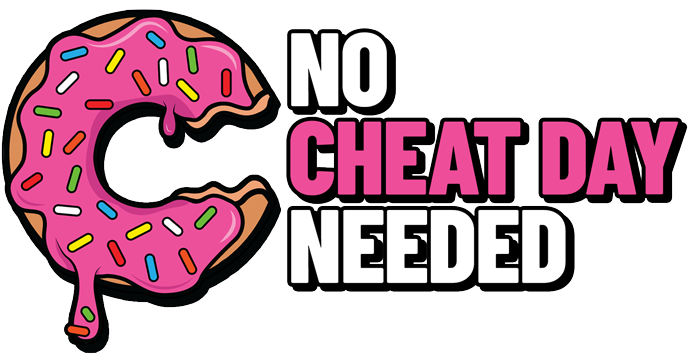Taco Bell Menu Nutrition Guide For 2025 (With High-Protein & Low-Calorie Options)
Can Taco Bell fit into a healthy diet? General consensus will probably tell you that Taco Bell could not possibly be healthy, but I’m here to convince you otherwise. We’re breaking down the entire Taco Bell menu so you can find the best options for your diet and lifestyle.
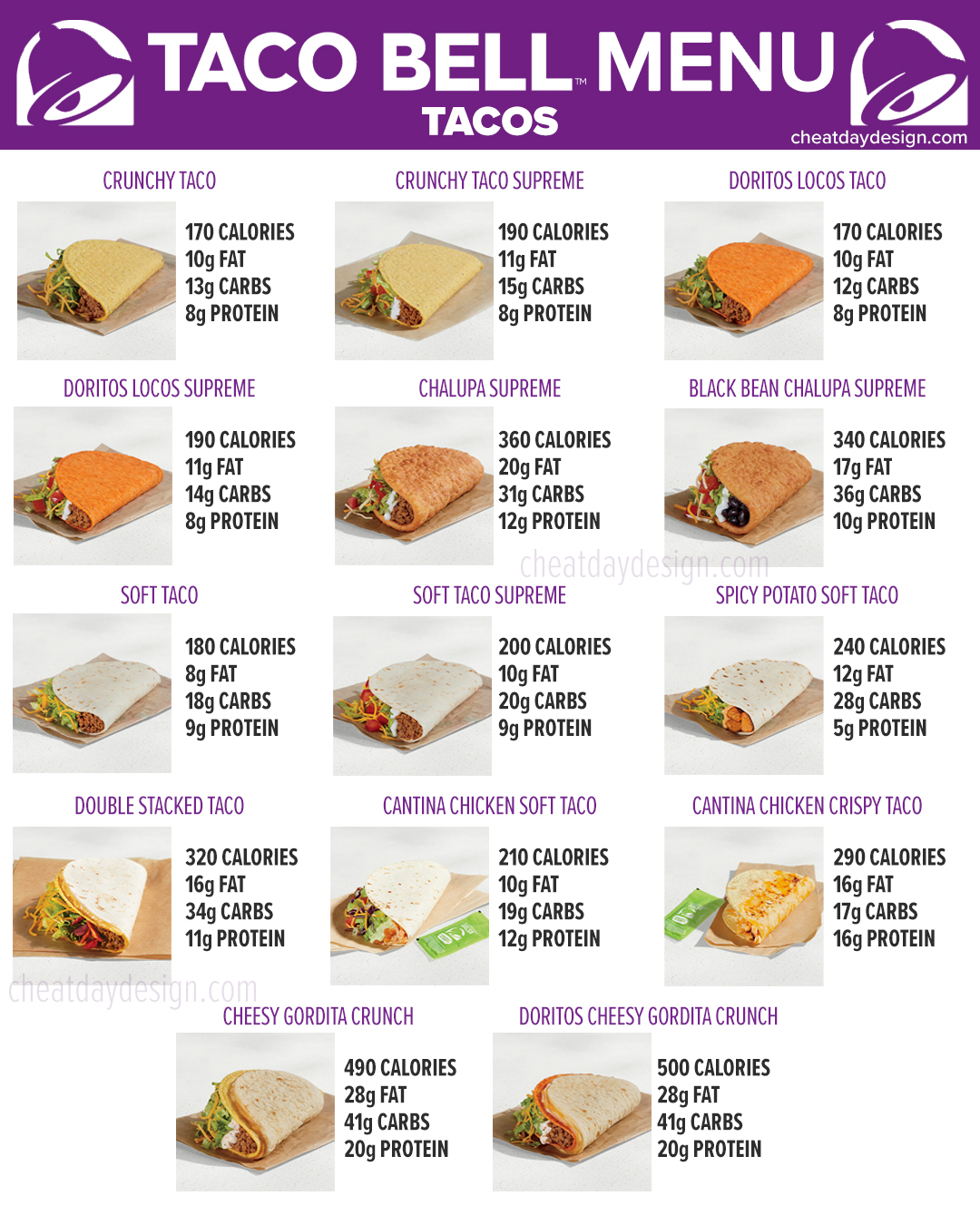
Highlights
- The Cantina Chicken Bowl with no rice or beans is the best keto-friendly option at Taco Bell, containing 280 calories, 18g fat, 5g net carbs, and 20g protein.
- The Soft Grilled Chicken Taco Fresco Style is the best low-fat option, with 130 calories, 3.5g fat, 16g carbs, and 11g protein.
- Ordering “fresco style” is a great way to save calories, while ordering extra meat is the easiest way to maximize protein of any item.
Before we dive in, I want to hit you with a few overall notes regarding ‘s menu in general.
First and foremost, I should preface this post by acknowledging that you’re likely not looking to eat at Taco Bell to be specifically “healthy.” Generally speaking, you’re not going to a restaurant in search of the healthiest (with fast-food chains like Subway or Panera being general exceptions).
That being said, I always find it useful to understand what it is that I’m eating even if I’m not overly concerned with eating the healthiest options.
It’s not about always trying to be as healthy as possible, but it’s about knowing what choices are best to make for YOU.
In doing research for this post, it’s clear to me that Taco Bell has some quality options for healthy eating.
- Understanding Taco Bell’s Rotating/Limited Menu
- What are the Healthiest Options at Taco Bell?
- Nutrition Facts for Taco Bell Tacos
- Nutrition Facts for Taco Bell Burritos & Quesadillas
- Nutrition Facts for Taco Bell Specialties
- Nutrition Facts for Taco Bell Sides & Sweets
- The Healthiest Breakfast Items at Taco Bell
- How to Save Calories at Taco Bell: Order Fresco Style
- Build Your Own Macro-Friendly Taco Bell Order
- Final Note: is Taco Bell healthy?
Understanding Taco Bell’s Rotating/Limited Menu
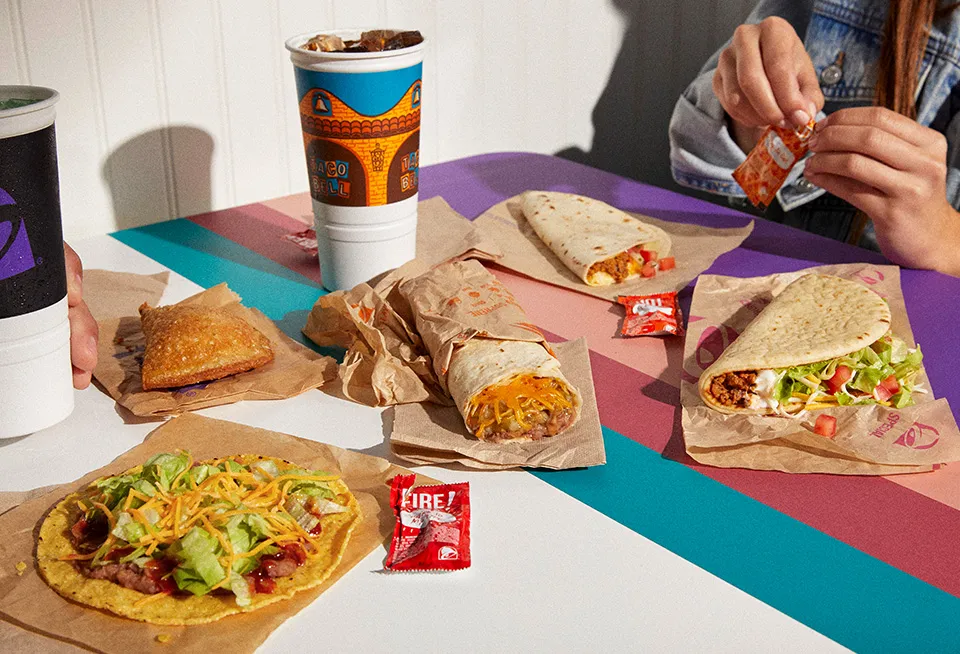
Ever fall in love with a Taco Bell menu item only to have it vanish a few weeks later? Don’t worry, you’re not going crazy – it’s all part of Taco Bell’s “Experience” system.
Taco Bell rotates their limited-time items through what they call “Experiences,” which are basically month-long windows where they introduce new items or bring back fan favorites. For example, as I write this in January 2025, they’re wrapping up Experience 1 (their crispy chicken nuggets promotion) and getting ready to launch Experience 2 with Cheesey Dipping Burritos.
The “Decades” menu was recently introduced, but it’s also being phased out.
Some items, like our beloved Nacho Fries, might stick around for multiple Experiences because they’re just that popular. Others might only last for a single Experience, or sometimes even less if they sell out (I’m still mourning the loss of the Cool Ranch Doritos Locos Tacos).
Here’s why I’m telling you this: While this guide breaks down the nutrition facts for Taco Bell’s menu items, keep in mind that some menu items are most certainly going to be missing from this guide. Since Taco Bell is constantly introducing and removing limited items, it’d be impossible to update my infographics with every single item.
But don’t worry – the core menu items and the overall nutrition principles in this post will help you make informed choices, whether you’re ordering the classics or trying whatever new creation Taco Bell has dreamed up this month.
Now, let’s dive into what you really came here for – breaking down those nutrition facts and helping you figure out how to satisfy your Taco Bell cravings while staying on track with your goals.
What are the Healthiest Options at Taco Bell?
Before we break down the full menu, let’s explore what some of the healthiest options are for specific diets.
Note that as we go through this post in general, I won’t necessarily be touching on things like saturated fat or worrying about how many milligrams of sodium or grams of fiber an item may have.
While those things are great to look at when determining healthy options, we’re going to look strictly at calories and macronutrients for simplicity’s sake.
The best keto-friendly option at Taco Bell

Cantina Chicken Bowl With No Rice or Beans
280 Calories, 18g Fat, 5g Net Carbs, 20g Protein
Ordering a Chicken Cantina Bowl without the rice or beans will instantly give you a great keto-friendly option that is still plenty filling.
The bowl itself contains 10 grams of carbs, but with 5 grams of fiber, the “net carbs” come to only 5 grams.
This includes all of the sauces as well, but if you choose to leave those out (guacamole, ranch, and sour cream), the total carbs will come down to 7 grams with the net carbs at only 3 grams.
Best low-fat option at Taco Bell
Soft Grilled Chicken Taco Fesco Style
130 Calories, 3.5g Fat, 16g Carbs, 11g Protein
A chicken soft taco is a great way to eat low-fat and low calorie. These are two swaps that will go a long way in saving you calories and/or fat when ordering at Taco Bell:
1) Swapping ground beef for grilled chicken.
2) Asking for your food “fresco style,” which swaps out cheese & dairy-based sauces for tomato.
We’ll dive more into fresco-style options in a little bit.
Highest protein option at Taco Bell
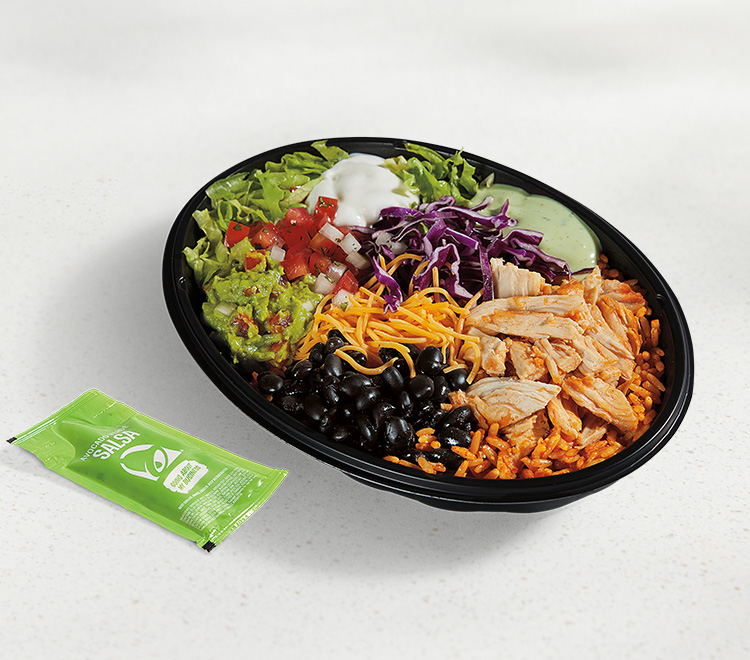
Cantina Chicken Bowl with Extra Chicken, Beans, and Cheese
600 Calories, 27g Fat, 52g Carbs (16g Fiber), 38g Protein
If you want to maximize your protein, ordering a bowl is your best bet because you can pack more of the good stuff in it. With this order, I bumped up the chicken, beans, and cheese, and it bumped the protein up from 25 grams all the way to 38 grams.
The 600 calories do not include the ranch sauce or sour cream (but does include the guacamole), so you’ll want to take those into account if placing an order.
Nutrition Facts for Taco Bell Tacos

Tacos are understandably the most popular items at Taco Bell (if you’re asking me, the Doritos Locos Taco is the best tasting on the menu, but many will argue for the Cheesy Gordita Crunch), but what you see here is not all you are limited to thanks to countless substitution options.
Lucky for us, whether you prefer flour tortilla, hard shell, double-stacked, or chalupa, there are countless options to choose from.
The tacos listed here are if you order them exactly as-is, but there are plenty of substitutions you can make to save some calories or up the protein.
Let’s take the Soft Taco Supreme and make some changes to see how it affects the final nutrition.
As is, the Soft Taco Supreme is 200 Calories, 10g Fat, 20g Carbs, and 9g Protein.
If you want to save some calories and bump up the protein a bit, you can swap the beef for grilled chicken. That will change the taco to 180 Calories and 13g of Protein.
Another option you have is to order the taco “fresco style.” Fresco simply means swapping out the dairy (cheese and sour cream) and mayo-based sauces for tomatoes. This will work for either a crunchy taco or a soft taco.
In this case, ordering the Soft Taco Supreme “fresco style” changes the nutrition to 160 Calories, 7g Fat, 18g Carbs, and 8g Protein.
Finally, you can make any of the tacos vegetarian by ordering a black bean taco instead of seasoned beef, chicken, or steak.
For the ultimate calorie saver, you can make your order vegetarian AND fresco style. In this case, the same taco would end up being just 140 calories- not bad!
Lowest Calorie Taco at Taco Bell

Crunchy Taco: 170 Calories | 10g Fat | 13g Carbs | 8g Protein
Highest Calorie Taco at Taco Bell

Doritos Cheesy Gordita Crunch: 500 Calories | 28g Fat | 41g Carbs | 20g Protein
Best Taco for High-Protein

Chicken Taco: 250 Calories | 7g Fat | 24g Carbs | 22g Protein
To maximize your protein at Taco Bell, you need to get a little bit creative. There’s an entire guide to taco customizations a little bit lower in this guide, but here’s a custom soft taco you can order that has the macros of a protein bar:
Order a soft taco with extra grilled chicken, easy (light) cheese, black beans, tomatoes, and lettuce. Not only will it be filling, but it will help you crush those protein goals.
Nutrition Facts for Taco Bell Burritos & Quesadillas

After tacos, burritos are the most popular items at Taco Bell. In terms of portability, you simply cannot beat the burrito.
By looking over the items here, you can see that the calories vary quite a bit, from 360 calories in the smaller bean burrito, all the way up to 710 calories with the Grilled Cheese Burrito.
Taco Bell introduces limited-time burritos fairly often throughout the year, so be on the lookout for new options that may have missed this graphic when it was created.
When it comes to deciding what to order here, aside from calories, protein may be the largest differentiator.
If you’re looking to maximize your protein intake (that would be my goal), adding extra meat to a burrito will give you the best bang for your buck.
For example, a Beefy 5-Layer Burrito will go from 17 grams of protein up to 21 grams of protein with extra seasoned beef, and up to 28 grams of protein if you swap the beef out completely for extra chicken.
Overall, the nutrition facts of these burritos and quesadillas will vary greatly if you opt to leave out the extra cheese sauce or other dairy-based sauces like sour cream.
If you leave those out and focus on other items such as black beans, refried beans, or pico de gallo, you’ll bring those calories way down overall.
Lowest Calorie Burrito at Taco Bell
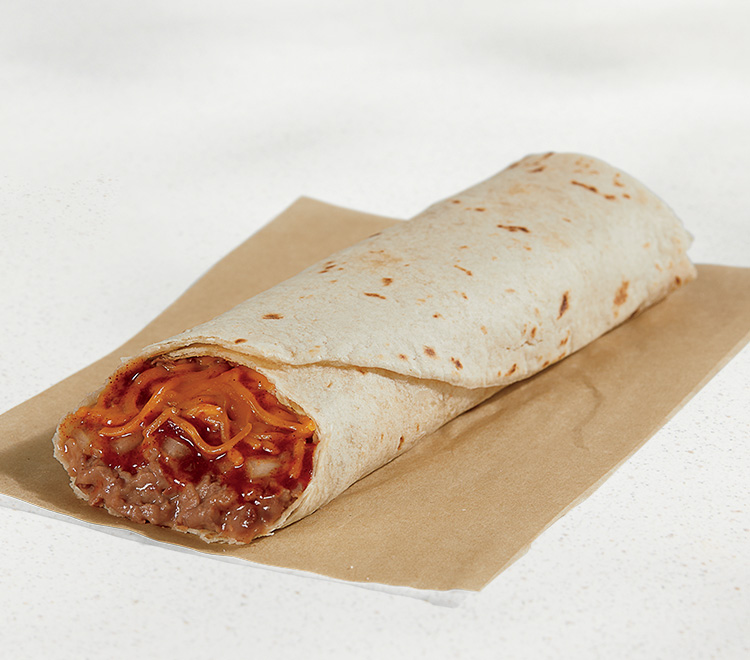
Bean Burrito: 360 Calories | 10g Fat | 54g Carbs | 13g Protein
A bean burrito is about as simple as you can get: beans, cheese, sauce, and onions. If you want to keep the calories low, this is a great route.
Highest Calorie Burrito at Taco Bell

Grilled Cheese Burrito: 710 Calories | 39g Fat | 64g Carbs | 25g Protein
The Best Options for High-Protein

Steak or Chicken Quesadilla: 520 Calories | 26g Fat | 41g Carbs | 26g Protein
You’d think burritos would be protein-packed, but the burrito with the most protein is the steak grilled cheese burrito, which contains 28 grams of protein with 700 calories. Not exactly an amazing protein source.
Instead, go for a quesadilla. The chicken and steak quesadillas both contain 26 grams of protein with 500 calories, and you can sneak in some extra protein by opting for extra meat.
Nutrition Facts for Taco Bell Specialties

Taco Bell is going to continue rotating nacho fries on and off the menu to keep the demand up (which I find annoying, but it is what it is), but it looks like they’re here to stay.
Much like French fries at most fast-food restaurants, the amount of fries you receive is going to vary greatly depending on the day and Taco Bell location, but you do have the option to stick with a “regular” side of fries or a large.
If your server is in a good mood, you may get a much more generous serving on any given day, so the calories may be a bit higher than what you see listed here.
In addition to Nacho Fries, we’ve got some long-time Taco Bell favorites on this menu: Crunchwraps, Mexican Pizza, Tostadas (currently limited but I would bet they’re going to stick around), and bowls.
Before this year, Taco Bell offered a “Power Bowl” option, but since the Cantina Chicken menu was introduced, it has since replaced the power bowl. If you were a fan of the previous version, don’t worry, the ingredients are essentially exactly the same.
Lowest Calorie Specialty Item at Taco Bell

Cheesy Roll Up: 180 Calories | 9g Fat | 17g Carbs | 8g Protein
Highest Calorie Specialty Item at Taco Bell

Nachos BellGrande: 740 Calories | 39g Fat | 80g Carbs | 17g Protein
The Best Taco Bell Specialty Item for Protein
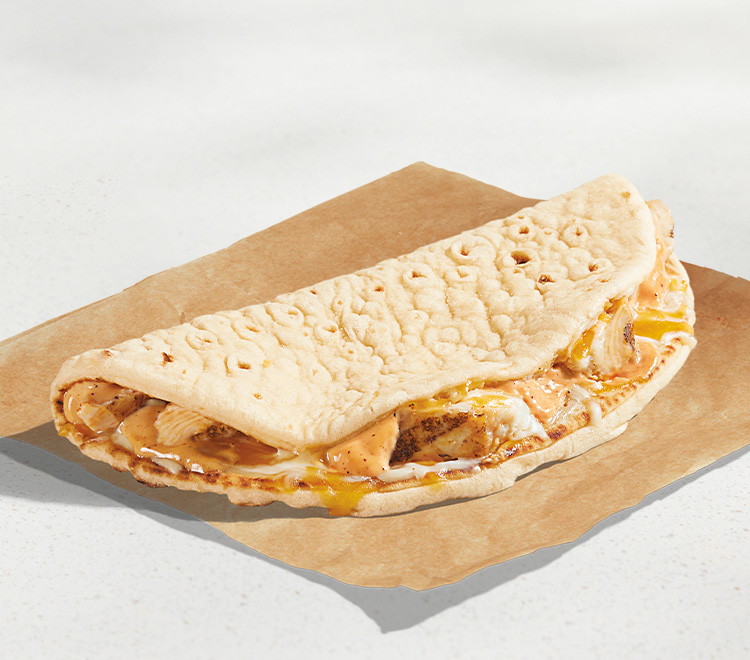
3 Cheese Chicken Flatbread: 330 Calories | 15g Fat | 29g Carbs | 20g Protein
If you want to easily customize an order to maximize your protein, ordering a Cantina Chicken Bowl with substitutions will be your best bet. If you order that bowl as-is, you’ll be getting 25 grams of protein with 490 calories, which is why I am giving a slight edge to this flatbread.
With 330 calories, the 20 grams of protein is a bit more impressive. For the math nerds out there, that’s about 25% protein in the flatbread vs just 20% in the bowl.
Nutrition Facts for Taco Bell Sides & Sweets
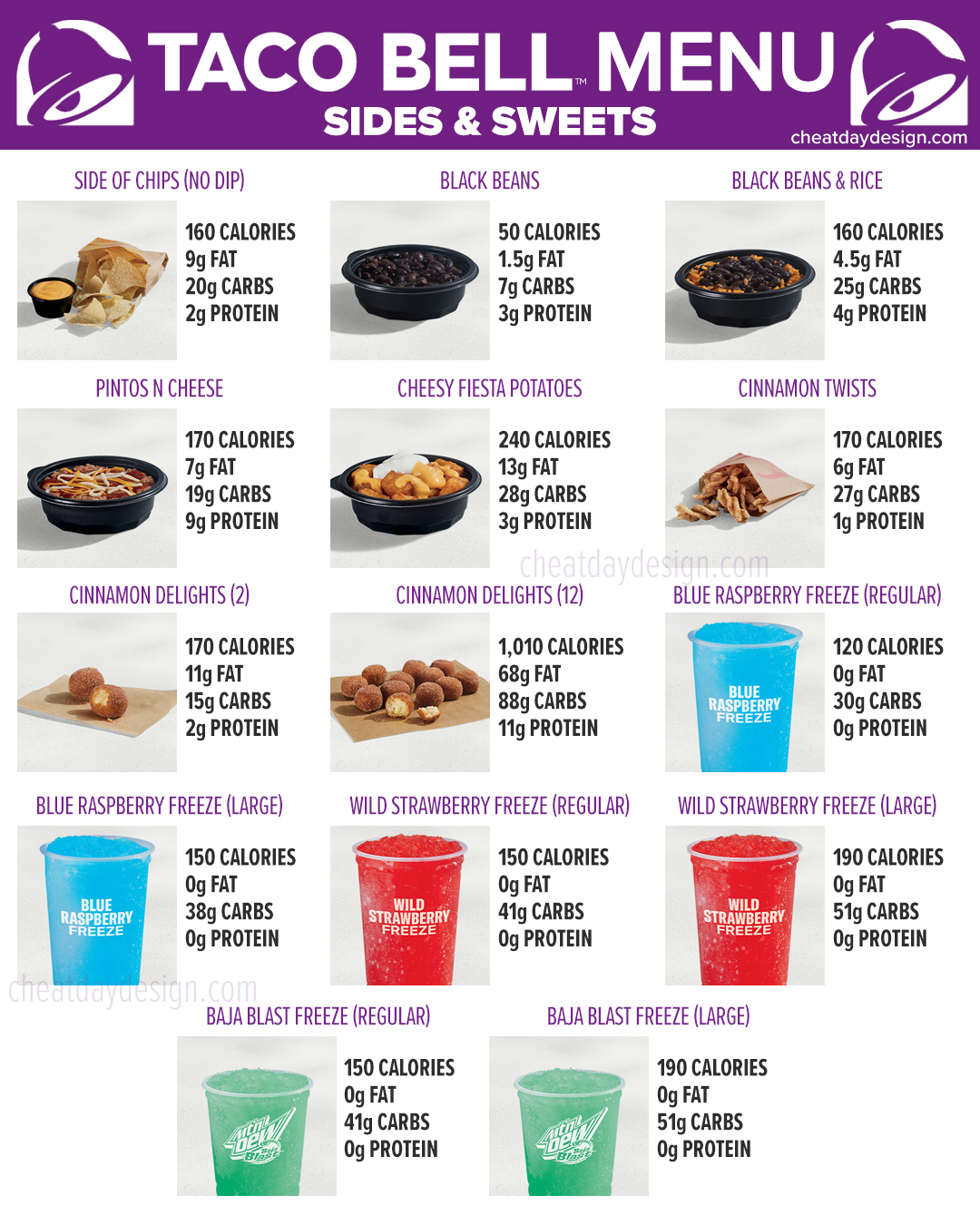
I won’t break down the sides & sweets in too much detail, because the “best” options here are pretty obvious.
I mean, if you want to keep your calories down, ordering a side of black beans is clearly a better choice than a side of Cinnamon Twists or Cheesy Potatoes.
But hey, it never hurts to see a breakdown of the options.
I wanted to include the “Freeze” options here, because I was surprised to see that even the large options clock in under 200 calories. While that may feel like a lot for some people, I find these drinks absolutely delicious, so it’s nice to see that they are not insanely high in the calorie department.
The Healthiest Breakfast Items at Taco Bell

I’ve never had breakfast from Taco Bell, but looking at their options, I’m very tempted to give it a try.
With breakfast options, you have less room for substitutions or calorie savers, but that doesn’t mean you’re completely out of luck.
If breakfast meat (bacon or breakfast sausage) isn’t your cup of tea, you have the option to swap it for grilled steak instead. And who doesn’t love steak and eggs?
For a small calorie saver, you can always take the cheese out of any of the options as well.
It may not seem like much, but if you were to order the cheesy toasted breakfast burrito with steak and no nacho cheese sauce, it would bring the total calories to 310. It’s not huge savings, but it’s something!
And of course, you should always pair your breakfast with a crispy hashbrown. Hash browns are pretty much non-negotiable in my mind when ordering fast food breakfast (or any breakfast, for that matter).
Lowest Calorie Breakfast Item at Taco Bell

Cheesy Breakfast Burrito Potato: 340 Calories | 14g Fat | 44g Carbs | 9g Protein
Highest Calorie Breakfast Item at Taco Bell

Breakfast Sausage Crunchwrap: 750 Calories | 49g Fat | 53g Carbs | 21g Protein
The Best Taco Bell Breakfast for High-Protein

Steak Breakfast Quesadilla: 510 Calories | 25g Fat | 41g Carbs | 28g Protein
Many of the breakfast options contain at least 20 grams of protein, so you have a bunch of options to choose from, but a lot of those options come with a lot of calories.
For the best protein-to-calories ratio, choose the steak breakfast quesadilla. With just over 500 calories and nearly 30 grams of protein, it’s a seriously impressive high-protein option.
How to Save Calories at Taco Bell: Order Fresco Style

Fresco Style isn’t technically its own menu, but rather a style of ordering you can choose (like “animal style” at In-N-Out).
If you order anything “Fresco Style,” it replaces any mayo or dairy-based sauces (like avocado ranch sauce), , , and sour cream, with freshly diced tomatoes.
Depending on what you order, that can lead to huge calorie savings.
If calories aren’t a concern, fresco items are also great for anyone who chooses to (or has to) eat dairy-free.
To get an idea of the calorie savings, a regular Soft Taco Supreme with beef contains 210 calories. If you order that Soft Beef Taco “fresco style,” it’ll bring the calories all the way down to 160.
Personally, I find a fresco crunchy to be even better than one with on it!
Small savings can go a long way, especially if you’re ordering multiple items.
Build Your Own Macro-Friendly Taco Bell Order
Since the menu items at Taco Bell are so customizable, I wanted to put together a guide to help you visualize your own high-protein, low-calorie Taco Bell order.
Choose a soft shell or crunchy sell, select a protein, then choose your toppings to build the ultimate macro-friendly Taco Bell order.

Other toppings are not listed here, like tomatoes, onion, and lettuce, but they add virtually no calories, so I decided to leave them off.
Surprisingly, the amount of meat you get is the same in a single taco and a burrito (at least according to the nutrition calculator on Taco Bell’s website) so you can use the above infographic to build a burrito as well.
You’ll see that sauces add minimal calories to a taco. For example, spicy ranch sauce adds only 30 calories to each taco because it is a small amount. Be mindful if you order that same sauce as a side- in the cause of spicy ranch, you’re getting 7 times the sauce, so those calories can add up quickly.

If you want some inspiration for macro-friendly options at Taco Bell and don’t want to put them together yourself, I created some options to get you started.
There is not one single best option because you can easily switch up an order to fit your specific macro needs, but these are all high-protein, healthy options you can order:
1. Grilled Chicken Doritos Locos Taco
Order a Doritos Locos Taco, but swap the beef for grilled chicken and add extra grilled chicken.
190 Calories, 7g Fat, 12g Carbs, 19g Protein
2. Bean Burrito With Steak
Order a bean burrito, but add extra steak for added protein.
460 Calories, 14g Fat, 57g Carbs, 28g Protein
3. Grilled Chicken Protein Bowl
Order a power bowl with extra grilled chicken, black beans, seasoned rice, easy/light cheddar cheese, lettuce, tomatoes, and the hot sauce of your choice.
390 Calories, 12g Fat, 38g Carbs, 32g Protein
4. Steak Quesadilla
Order a quesadilla with extra steak and ask for no creamy jalapeno sauce.
500 Calories, 23g Fat, 42g Carbs, 33g Protein
5. Steak & Eggs Breakfast Burrito
Order a cheesy toasted breakfast burrito without bacon, add extra steak, ask for extra eggs, and ask for easy/light nacho cheese.
440 Calories, 20g Fat, 39g Carbs, 27g Protein
Final Note: is Taco Bell healthy?

While Taco Bell has historically gotten a bad rap for using low-quality ingredients, that has certainly changed in recent years.
When you break down the menu, you can see that there are some real quality options. If you’re looking for fresh food, a Taco Bell restaurant is actually not a bad choice at all.
Nutritionally, it’s only as “unhealthy” as you make it. If you know what substitutions to make, the Taco Bell menu can be quite healthy.
All in all, if you’re looking for low-calorie options, you’ll want to limit the nacho cheese, sour cream, guacamole, or heavy sauces.
“Fresco style” without the cheese or sauce will save a ton of calories in some cases, and will still be very delicious with the addition of the salsa.
Ultimately, if you’re going to eat a meal at Taco Bell, you certainly do not need to worry about nutrition. You’re likely looking for a treat, in which case you can enjoy any item you’d like without worrying about the calories.
If you want to just enjoy some tacos without the thought of calories or macros, you absolutely should.
That being said, I always find it helpful to be educated about the nutrition of the food I’m eating. Whether or not I’m actively tracking my macros or counting my calories, I find it incredibly helpful to have a general idea of the calories and macros I’m consuming.
